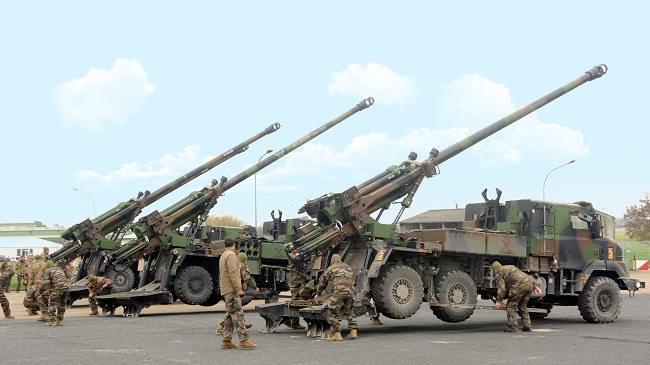
France is one of the countries that has spent the most on military assistance to Ukraine through the delivery of CAESAR self-propelled artillery, VAB and AMX-10 vehicles, SCALP EG missiles and HAMMER guided bombs, as well as the MIRAGE 2000-5 with the associated training of pilots and specialists, carried out in a far more satisfactory timeframe than the international ‘consortium’ engaged in the deployment of the F-16 capability.
Somewhat less well known was the French effort to train a large brigade-level unit for the Ukrainian Army. The Kiev Armed Forces have repeatedly benefited from international assistance (US, Polish, British, etc.) for training their own troops. However, these have almost always been limited to training for smaller units and capacity-building measures for niche or staff functions, or for familiarisation with Western weapon systems (such as PATRIOT, ABRAMS, or LEOPARD 2, to name but a few examples).
The training of an entire brigade therefore constitutes the first real commitment of this kind. Named 155th Independent Mechanised Brigade, it was christened, as a concession to an all-French taste, ANNE OF KIEV, a princess of Kievan Rus who became Queen of France shortly after the year 1000, following her marriage to Henry I. The motto was also kept in French: ‘on ne passe pas’.
Assigned to the Pokrovsk front, the ANNE OF KIEV immediately suffered major LEOPARD 2 losses. Worse still, it did not arrive on the frontline at all with its 5,800 personnel, as no less than 1,700 of them were missing from roll call.
The Brigade, which had returned from intensive training in France (and partly in Poland) in the autumn of last year, was slow to be deployed operationally due to known shortcomings in term of equipment, as it lacked drones and C-UAV and electronic warfare systems. The estimated cost is around EUR 900 million, 80 % of which could be calculated on the basis of the French (CAESAR, VAB, AMX-10) and Spanish (LEOPARD 2 tanks) equipment received.
Now we know that poor equipment in certain sectors is not the only problem, as the SBU (Sluzhba bezpeky Ukrainy, Ukraine's internal security agency) has officially opened an investigation about the clamorous high rate of desertions, in conjunction with the decision of the Ukrainian Chief of Staff, General Oleksandr Syrsky, to torpedo the Brigade Commander, General Dmytro Ryumshin, and a good part of his staff.
There had already been rumours of some 50 defections that occurred during training on French soil. Today we know that, in fact, between March and October 2024 (i.e. the period in France), there were as many as 935 deserters.
Classified, according to Ukrainian military justice, as a kind of AWOL (Absence Without Official Leave), it is unknown how many of them actually returned to the unit, and it is likely that they can be considered deserters.
In addition, it was reported that some 2,550 soldiers who participated in the first months of training in France had, by mid-summer, been repatriated to replenish line units bled dry on the fronts. This meant that the replacements, sent to France in the autumn, had very little amalgamation with their respective units in terms of training.
In fact, it was among these soldiers that the other AWOL/desertion cases later occurred in Ukraine (i.e. the 1,700 missing men, not including the aforementioned 935). As we write, about 500 ‘rogue’ soldiers would have returned.
Added to these issues was the unfortunate case of the sudden death, from a heart attack, of one of the Brigade's most senior officers. But it is clear that, in reality, there are far more structural problems in this large unit (which would be the largest of all Ukrainian Army brigades).
A quick analysis on the social media, widely used by the Ukrainian military, shows merciless diagnoses that, more or less, converge on a fundamental point: a generalised distrust of the troops in the Brigade itself. This would be motivated by the following, rather recurrent arguments:
- the training received by the French, as it was judged unsuited to the realities of the war in Ukraine (read: the absence of training on drone warfare and counter-drone warfare);
- related to this (as we had already indicated) was the very absence of drones (apart from a tiny portion of 137 MAVIC 3s, of which the personnel destined for deployment had very little experience), electronic warfare equipment, and even reactive armour and passive protection grids for tanks and armoured vehicles;
- the insufficient presence of both subordinate officers among the Brigade's tactical sub-units and specialist personnel capable of truly ensuring the full and proper functioning of the Western equipment received (and in fact, it seems that VABs and AMX-10s are not even deployed operationally, as are 120 mm mortars, while CAESARs are used for very basic fire missions);
- almost complete lack (estimated at around 95%) of personnel with previous combat experience;
- the fact that the Brigade, upon its return home, was initially assigned to the Pokrovsk front without the Command and its staff, most of whom were still in training in France!
It seems that in November, when the Brigade was already in Ukraine, the Ukrainian General Staff had realised the disastrous state of affairs, and had tried to improve the situation through intensive training sessions conducted by personnel with great operational experience drawn from the 10th Mountain Brigade.
As a consequence, the Brigade's readiness had been officially classified as ‘unready’. Political considerations, however, led its status to be declared ‘satisfactory/combat ready’ within a few weeks, when the first echelons of the Brigade were sent to the Pokrovsk front, with the results we have already mentioned.
It is rumoured that the Brigade has now been disbanded, something that cannot be confirmed at the moment (although an official decision may well be imminent). As we write, the Brigade is used as a sort of ‘force provider’ of its few more or less efficient assets for the benefit of other units that are engaged on the Pokrovsk front, such as the 108th Independent Mechanized Battalion, the 25th Airborne Brigade, and the 68th Hunters Brigade. Perhaps these assets will gain the necessary operational experience, and we will see if this will revitalise the 155th Mechanised Brigade.
Otherwise, should the dismantling of the Brigade be confirmed, a new approach to the Ukrainian ‘force generation’ procss should be adopted. A possible solution is abandoning the training of large units and, rather, focusing on tactical assets (companies, battalions) to reinforce/replace highly experienced units with which and from which to generate the necessary fellowship and learn the indispensable lessons.








.png)
